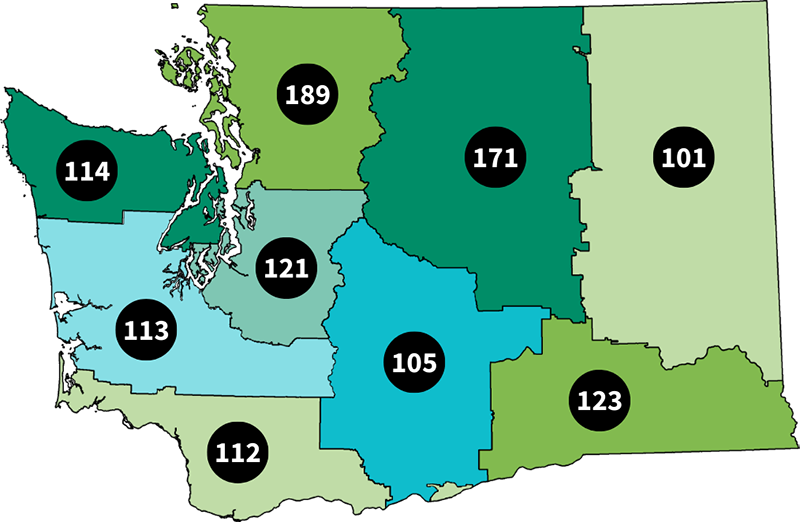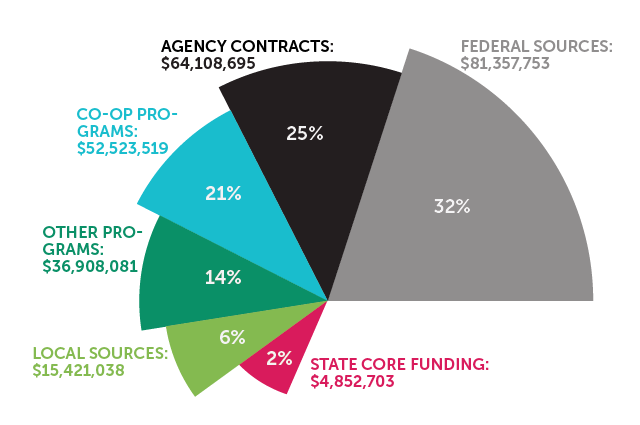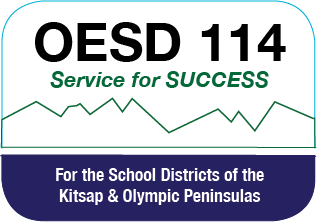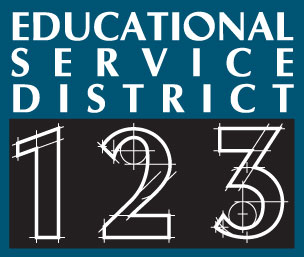Our Educational Service Districts
Nine ESDs – One Goal
Each of Washington’s nine Educational Service Districts (ESDs) provides essential local services, responsive to their region’s communities.
Click on each region to see more information
Washington ESDs serve
- 1 million+ students
- 295 School Districts
- 700+ Private Schools
- 18 Public Charter Schools
- 8 State Tribal Education Compact Schools (STECs)
- 2 State Schools

ESD 189: Northwest
- 35 School Districts
- 1 tribal compact school
- 1 public charter school
- Superintendent:
Ismael Vivanco
Counties: Island, San Juan, Skagit, Snohomish, and Whatcom
1601 R Avenue, Anacortes, 98221
tel: 360.299.4000 | www.nwesd.org
ESD 114: Olympic Region
- 15 School Districts
- 2 tribal compact schools
- 1 public charter school
- Superintendent:
Aaron Leavell
Counties: Kitsap (except Bainbridge Island), Jefferson, and Clallam
105 National Ave. N., Bremerton, 98312
tel: 360.405.5801 | www.oesd114.org
ESD 113: Capital Region
- 44 School Districts
- 1 tribal compact school
- Superintendent:
Flip Herndon
Counties: Thurston, Mason, Lewis, Pacific, and Grays Harbor
6005 Tyee Drive SW, Tumwater, 98512
tel: 360.464.6700 | www.esd113.org
ESD 112: Southwest Washington
- 30 School Districts
- 2 State Schools
- Superintendent:
Tim Merlino
Counties: Clark, Skamania, Cowlitz, Wahkiakum, Klickitat, and Pacific
2500 N.E. 65th Ave., Vancouver, 98661-6812
tel: 360.750.7503 | www.esd112.org
![]()
ESD 121: Puget Sound
- 35 School Districts
- 2 tribal compact school
- 10 public charter schools
- Superintendent:
John Welch
Counties: King and Pierce
800 Oakesdale Ave. SW, Renton, 98057
tel: 800.664.4549| www.psesd.org
ESD 171: North Central
- 29 School Districts
- 1 public charter school
- 1 tribal compact school
- Superintendent:
Dr. Michelle Price
Counties: Chelan, Douglas, Grant, and Okanogan
430 Old Station Road, Wenatchee, 98801
tel: 509.665.2610| www.ncesd.org
ESD 105: South Central Washington
- 25 School Districts
- 1 tribal compact school
- Superintendent:
Shane Backlund
Counties: Kittitas and Yakima counties, and portions of Klickitat and Grant
33 S. 2nd Ave., Yakima, 98902-3486
tel: 509.575.2885 | www.esd105.org
ESD 112: Southwest Washington
- 30 School Districts
- 2 State Schools
- Superintendent:
Tim Merlino
Counties: Clark, Skamania, Cowlitz, Wahkiakum, Klickitat, and Pacific
2500 N.E. 65th Ave., Vancouver, 98661-6812
tel: 360.750.7503 | www.esd112.org
![]()
ESD 101: Northeast Washington
- 59 School Districts
- 4 public charter schools
- Superintendent:
Rob Roettger
Counties: Adams, Ferry, Lincoln, Pend Oreille, Spokane, Stevens and Whitman
4202 S. Regal, Spokane, 99223-7738
tel: 509.789.3800 | www.esd101.net
ESD 123: Southeast Washington
- 23 School Districts
- Superintendent:
Steve McCullough
Counties: Adams, Asotin, Benton, Columbia, Franklin, Garfield, and Walla Walla
3918 W. Court St., Pasco, 99301
tel: 509.547.8441 | www.esd123.org
About Educational Service Districts
In 1969, Educational Service Districts (ESDs) were formed when individual County Superintendent of School offices were consolidated and reorganized to reduce duplication, equalize educational opportunities, and provide a more effective reporting and accountability system to the state legislature.
ESDs link local public and private schools with one another and with state and national resources. ESD Cooperatives and programs enhance educational opportunities because they realize significant savings, allowing districts to send more dollars directly to the classroom and provide special services that might otherwise be unavailable to their regions.
As you can see, ESDs play a crucial role in addressing the challenges in our public schools. Geographically closer to local schools and their district offices, the ESDs serve as regional liaisons between the State Superintendent of Public Instruction (OSPI), State Board of Education, and the Legislature.
The ESD Return on Investment
As ESDs reach their fifth decade of service, the scope and nature of linking and service responsibilities reflect the change facing our public schools today. In a time of increased public accountability, of both student performance and management of public resources, ESDs in Washington are “the” model of efficiency and leverage. The nine ESDs leveraged $5.1 million of state allocated core funding into $251 million of needed services for students and schools in Washington. Stated another way, for every $1 in core funding, ESDs returned $49 in educational programs and services – $230 for every student in the state.

As our state’s citizens demand higher standards and ever increasing demands on educational programs, the ESDs of Washington state will continue to provide critical services such as teacher and staff training, networking and technology integration, and direct services for students with special needs and early childhood education. We will continue to create new opportunities, leverage more resources, and facilitate broad support for the benefit of all students and their families in Washington State.
Find your ESD
Filter by ESD, county or search by district name.
| School District | County | Educational Service District |
|---|---|---|
| Aberdeen School District | Grays Harbor County | Capital Region ESD 113 |
| Adna School District | Lewis County | Capital Region ESD 113 |
| Almira School District | Lincoln County | Educational Service District 101 |
| Anacortes School District | Skagit County | Northwest Educational Service District 189 |
| Arlington School District | Snohomish County | Northwest Educational Service District 189 |
| Asotin-Anatone School District | Asotin County | Educational Service District 123 |
| Auburn School District | King County | Puget Sound Educational Service District 121 |
| Bainbridge Island School District | Kitsap County | Puget Sound Educational Service District 121 |
| Battle Ground School District | Clark County | Educational Service District 112 |
| Bellevue School District | King County | Puget Sound Educational Service District 121 |
| Bellingham School District | Whatcom County | Northwest Educational Service District 189 |
| Benge School District | Adams County | Educational Service District 101 |
| Bethel School District | Pierce County | Puget Sound Educational Service District 121 |
| Bickleton School District | Klickitat County | Educational Service District 105 |
| Blaine School District | Whatcom County | Northwest Educational Service District 189 |







